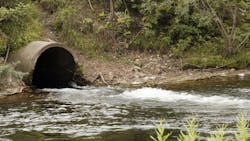The U.S. Environmental Protection Agency (EPA) has released a memorandum to states, providing direction on how to use the National Pollutant Discharge Elimination System (NPDES) to protect against per- and polyfluoroalkyl substances (PFAS).
The guidance outlines how states can monitor for PFAS discharges and take steps to reduce them where they are detected.
The action is an important step in the agency’s efforts to reduce the levels of PFAS entering wastewater and stormwater systems, ultimately lowering people’s exposure to PFAS through swimming, fishing, drinking, and other pathways.
“EPA is following through on its commitment to empower states and communities across the nation to address known or suspected discharges of PFAS,” says EPA Assistant Administrator for Water Radhika Fox. “Today’s action builds upon successful and innovative efforts already used by several states to safeguard communities by using our Clean Water Act permitting program to identify and reduce sources of PFAS pollution before they enter our waters.”
The memorandum, Addressing PFAS Discharges in National Pollutant Discharge Elimination System (NPDES) Permits and Through the Pretreatment Program and Monitoring Programs, will align wastewater and stormwater NPDES permits and pretreatment program implementation activities with the goals in EPA’s PFAS Strategic Roadmap.
The memo recommends that states use the most current sampling and analysis methods in their NPDES programs to identify known or suspected sources of PFAS and to take actions using their pretreatment and permitting authorities, such as imposing technology-based limits on sources of PFAS discharges. The memo will also help the agency obtain comprehensive information through monitoring on the sources and quantities of PFAS discharges, informing other EPA efforts to address PFAS.
Several states have already demonstrated the benefits of leveraging their state administered NPDES permit programs to identify and reduce sources of PFAS before these forever chemicals enter treatment facilities and surface waters.
Michigan, for example, is partnering with municipal wastewater treatment facilities to develop monitoring approaches to help identify upstream sources of PFAS. The state has been able to leverage that monitoring information to work with industries, such as electroplating companies, to substantially reduce PFAS discharges.
North Carolina has also successfully leveraged its NPDES program to develop facility-specific, technology-based effluent limits for known industrial dischargers of PFAS.
The memo urges states to replicate these approaches to identify and reduce PFAS discharges.
This memo builds upon the agency’s April 2022 memo to EPA Regions by expanding the audience to states and including new recommendations related to biosolids, permit limits, and coordination across relevant state agencies. The memo provides recommendations to NPDES permit writers and pretreatment coordinators, rooted in the successful use of these tools in several states, on monitoring provisions and analytical methods and the use of pollution prevention and best management practices.
These provisions will help reduce PFAS pollution in surface waters as the agency also works to promulgate effluent guidelines, finalize multi-laboratory validated analytical methods, and publish water quality criteria that address PFAS compounds.



